By Cristina Cabrera Jarro -
MIAMI | Jesuit Father Pedro Cartaya remembers shaking hands with astronaut Neil Armstrong.
On Aug. 5, 1969, the priest was in New York City, among the crowd waiting to see the parade for the Apollo 11 astronauts. As the vehicle with the astronauts came by, Father Cartaya was fortunate enough to quickly shake hands with the first human to walk on the moon. He told Armstrong, “Great job! God bless you.”
On July 20, the world marks the 50th anniversary of Apollo 11, the mission which allowed mankind to walk on the moon for the first time in history.
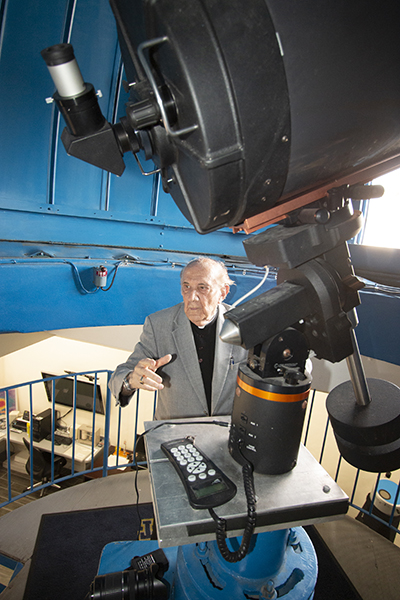
Photographer: ANA RODRIGUEZ-SOTO | FC
Jesuit Father Pedro Cartaya describes the attributes of Belen Jesuit Prep's observatory in Miami while standing next to the telescope. Belen is the only school in the United States equipped with a 16” telescope with a CCD (digital) camera for astrophotography.
“Armstrong stepped on the moon, leaving forever his footprint as a symbol of what he did. It was thrilling,” said Father Cartaya, an astronomy enthusiast who serves as spiritual counselor and chaplain to Belen Jesuit Prep’s Alumni Association.
He was 33, teaching and studying for his doctorate in literature at the University of St. Louis, Missouri, when he tuned in, along with millions around the globe, to witness the moon landing. He remembers watching the broadcast on a small, black-and-white TV. When Armstrong announced, “The Eagle has landed,” Father Cartaya could barely contain his excitement.
“I got so emotional that in the parish where I was staying, I was about to ring the bells, announcing to the world that for the first time in history mankind had achieved something that seemed impossible, touching something celestial outside of Earth,” he said.
Years later, another first from Apollo 11 was revealed: Astronaut Edwin “Buzz” Aldrin had received communion in space.
“Can you imagine that for the first time that man stepped onto the moon, the Eucharist was also consumed for the first time outside of Earth?” Father Cartaya noted.
Aldrin, with permission from his pastor at Webster Presbyterian Church in Texas, had brought bread and wine with him on the mission. About an hour before stepping onto the moon, he recalled in his memoirs, he read a passage from Scripture, drank the wine and ate the bread.
“For me, as a priest, it was twice as emotional to know that the first communion took place outside of Earth on the same day that man stepped on the moon. I am grateful to God for the talent that he has given to mankind and for the grace that Christ also needed to be present outside of the Earth,” said Father Cartaya.
Concerned about the separation of church and state, NASA refrained from sharing the moment with the public. Aldrin revealed it years later.
GOD IN SPACE
He was neither the first nor the last astronaut to remember God in space.
The crew of Apollo 8 read from the Book of Genesis on Christmas Day 1968, when they became the first humans to orbit the moon. Two weeks after Easter 1994, Catholic astronauts Thomas Jones, Sid Gutierrez, and Kevin Chilton — the latter an extraordinary minister of holy Communion — received the Eucharist on board the space shuttle Endeavor. Israeli astronaut Ilan Ramon reportedly recited the Kiddush, the Sabbath blessing for wine, on his last Friday aboard the space shuttle Columbia. (He and his fellow astronauts were killed when the shuttle disintegrated upon re-entry Feb. 1, 2003.) And in 2017, Russian cosmonaut Sergei Ryzhikov brought with him a relic of St. Serafim of Sarnov, a Russian Orthodox saint.
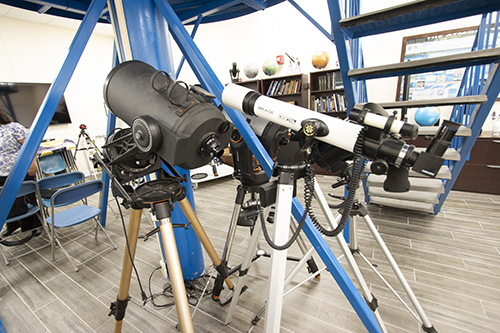
Photographer: ANA RODRIGUEZ-SOTO | FC
These are some of the array of telescopes used by astronomy students at Belen Jesuit Prep's observatory in Miami.
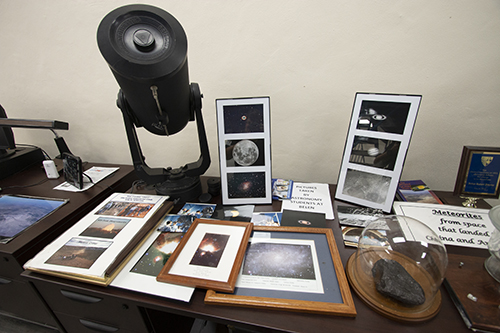
Photographer: ANA RODRIGUEZ-SOTO | FC
Photographs of the moon and stars taken by Belen Jesuit Prep students are on display at the school's observatory, the only high school observatory in South Florida.
Father Cartaya himself has had the honor of blessing astronauts heading out to space. In 1998, Belen Jesuit Preparatory School obtained permission from NASA to send a molecular DNA experiment aboard the space shuttle Discovery, to test the effect of zero gravity. The experiment was created by Belen students and encased in a metal box. One student had the honor of hand-delivering it to the shuttle. NASA even dressed the 16-year-old like an astronaut.
While Father Cartaya looked on, the astronauts going on the mission approached, and one of them spoke to the priest.
“He asked if I was a priest, a pastor or a rabbi, and was hoping for a blessing. Imagine, what a commitment. I couldn’t mention Jesus Christ because some of them were Jewish. I couldn’t mention the Virgin Mary because some of them were Protestant. I couldn’t mention God because some of them were atheists — no, that’s not true,” the priest joked.
“I told them I was honored and said, ‘I wish you all a very happy adventure and success in space, and since you are all aboard a shuttle named Discovery, I hope that you discover God beyond the stars,’” Father Cartaya recalled.
‘CREATE SOMETHING’
An astronomy enthusiast, Father Cartaya marvels at how far humanity has come since the Apollo 11 lunar landing. He called it a moment in history which served as a catapult to reaching something greater and continuing a legacy of exploration and creativity inspired by God.
“Creation is like a virtue that God gave us to continue his creative job. He said, ‘I created the world. Now create something for me and for man,’” Father Cartaya said.
Although he is retired from fulltime teaching, he still serves as director of the Padre Benito Viñes Observatory at Belen, the only one of its kind in any high school in South Florida. Father Cartaya’s students from the class of 1972 built and equipped the observatory.
“They designed it, they paid for it and they built it when they became architects and engineers,” Father Cartaya said.
The Miami observatory continues 164 years of tradition at the school, a tradition that began with the Belen Observatory in Havana, Cuba. The rooftop of Belen in Havana was also where a 13-year-old Cartaya saw his first astro-phenomenon.
He remembers he had gotten special permission from the school, and his parents, to spend the night on the rooftop, watching the sky. Around 2 a.m., enveloped in “darkness and solitude,” he watched as “an extraordinary meteorite passed over the sky of Havana. I was overwhelmed,” Father Cartaya said.
He credits the experience for sparking his lifelong passion for astronomy.
With the 50th anniversary of Apollo 11, he believes humanity is more than capable of returning to the moon, making it to Mars, and beyond.
“We get a better perspective of Earth being outside of Earth,” he said. “I think every time we leave Earth we return with more ideas, and a better perspective to improve all mankind. Returning to the moon is the opportunity to reproduce and recreate the opportunity to say, ‘How great is the universe that God has given us.’”
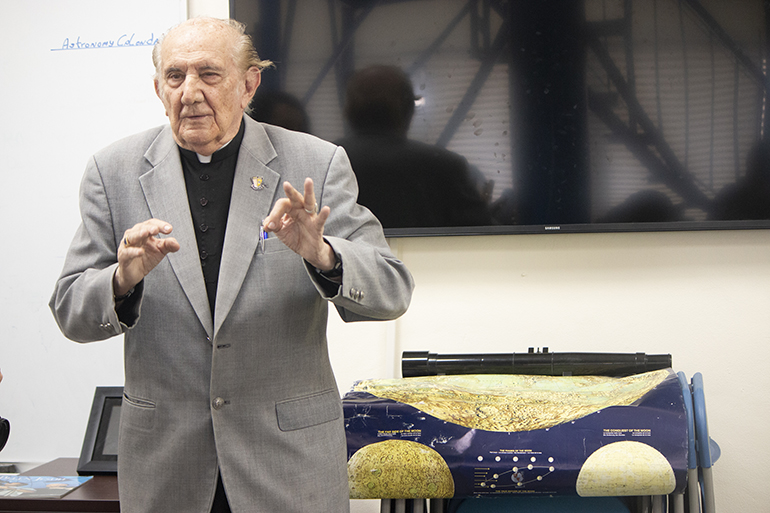
Photographer: ANA RODRIGUEZ-SOTO | FC
Standing next to a map of the moon, Jesuit Father Pedro Cartaya, Belen Jesuit Prep's resident astronomer, reflects on the 50th anniversary of the Apollo moon landing and its meaning for humanity.
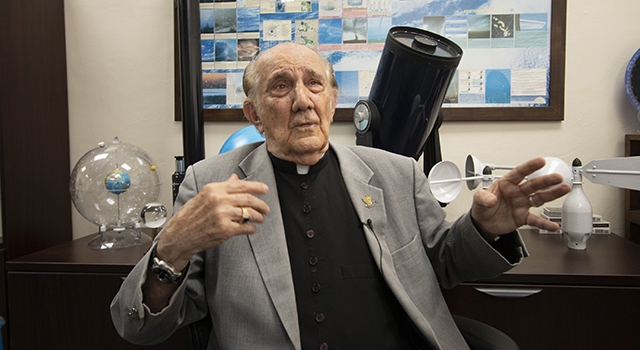

Comments from readers